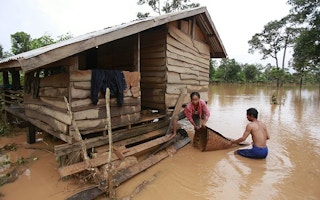A developer working on plans for the 770-megawatt Pak Lay hydropower project in northwestern Laos’ Xayaburi province told RFA’s Lao Service that developers are in the process of conducting a feasibility study and have not been informed by provincial authorities that they should stop their work.
“There have been surveys [conducted], but not too much progress has been made,” said the official who declined to be named.
“Though there was a press conference held by the prime minister to halt dam projects in Laos, local authorities have not come down to tell us to stop this project,” he said.
On August 8, the Mekong River Commission’s (MRC) Joint Committee Working Group (JCWG) for the procedures for notification, prior consultation, and agreement decided to begin a six-month prior consultation process for the Pak Lay dam the same day.
“
The prior consultation will afford the notified countries, the affected communities, and related stakeholders an opportunity to review the project and raise their legitimate concerns on adverse cross-border impacts on the environment and people.
Te Navuth, chair, Mekong River Commission’s Joint Committee Working Group
The MRC is an intergovernmental organisation that works directly with the governments of Cambodia, Laos, Thailand and Vietnam to jointly manage shared water resources and the sustainable development of the Mekong River.
Though the members consult each other and reach agreements on the construction of large dams, and perform research and planning on the environmental and social impacts of projects, the MRC lacks the authority to force members to delay or halt dam-building activities.
“The prior consultation will afford the notified countries, the affected communities, and related stakeholders an opportunity to review the project and raise their legitimate concerns on adverse cross-border impacts on the environment and people,” said JCWG chair Te Navuth in a statement issued by the MRC on August 10.
“It also allows the country proposing the project to better understand such concerns and to identify measures to address them,” he said.
Developers of the estimated U.S. $2.4 billion, 912-megawatt Pak Beng hydropower project in northwestern Laos’ Oudomxay Province also have not received an order from provincial authorities to halt or to review construction plans, said a developer who declined to be named.
“The Pak Beng project has not been ordered for review,” he told RFA. “They [provincial authorities] have ordered reviews other dam projects built of clay that would be affected by heavy rain, but for this dam, rain won’t be a problem.
“Everything is proceeding as usual, and nothing has changed,” he said.
Equal or greater power
On August 7, Lao Prime Minister Thongloun Sisoulith ordered hydropower developers to suspend consideration of new investments in dam projects pending review of the government’s hydropower development strategy and plans, and ordered all existing and future dam operators to submit regular safety reports.
The move was prompted by the collapse of a saddle dam that was part of the U.S. $1 billion Xe Pian Xe Namnoy hydropower project in southwestern Laos’ Champassak province on July 23. The breach displaced about 7,000 people in Champassak and neighbouring Attapeu province, with scores still missing.
The operators of the project, which was nearing completion, planned to sell most of the 1,880-gigawatt hours of electricity per year the dam was expected to generate to Thailand.
But in Laos, local authorities have equal or greater power than does the central government, allowing them to override a central order by the prime minister, including the recent one to stop new dam projects. Local authorities can also approve or reject proposals for new dams and order investigations and reviews of hydropower projects.
Officials said they will conduct reviews of the plans for the Pak Beng and Pak Lay projects, but that they believe the Chinese-backed mega-dams will be built because Chinese companies to date have always received approval for such projects.
When they are built, the Pak Beng and Pak Lay dams will be the third and fourth largest hydropower projects on the Mekong mainstream.
The Lao government hopes that its mega-dams will help it become the “battery of Southeast Asia” and turn it from being one of the region’s poorest nations into a middle-income country through sales of most of the hydroelectricity they produce to Thailand, Vietnam, and China.
Laos plans to eventually have about 140 dams with roughly 30 per cent of them already completed, though many of these are located on tributaries of the Mekong.
Environmental NGOs want the Lao government to halt dam construction along waterways in the country, warning that existing hydropower projects are having significant detrimental effects on the environment and on people’s livelihoods. They also fear that dam inspections by Lao officials will not be transparent.
Reported by RFA’s Lao Service. Translated by Sidney Khotpanya. Written in English by Roseanne Gerin. Used with the permission of Radio Free Asia, 2025 M St. NW, Suite 300, Washington DC 20036.










